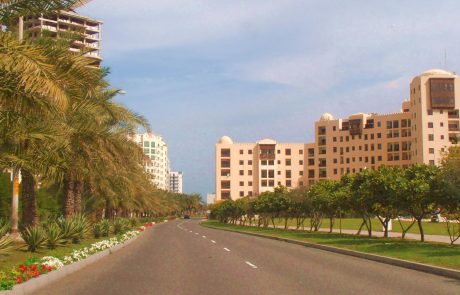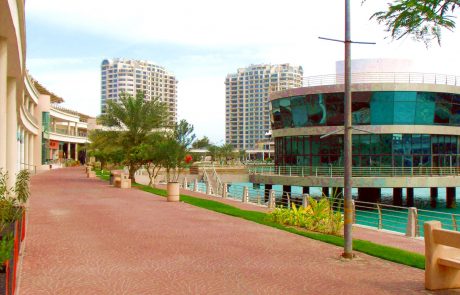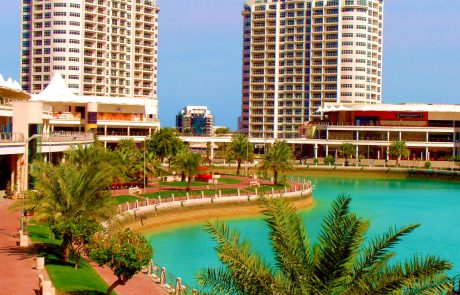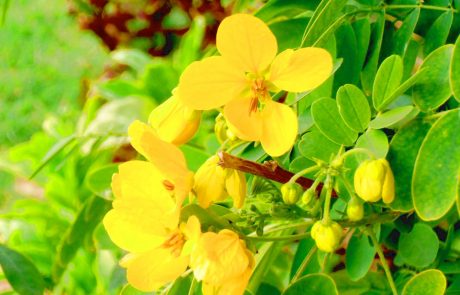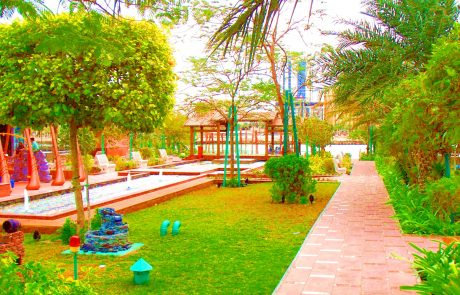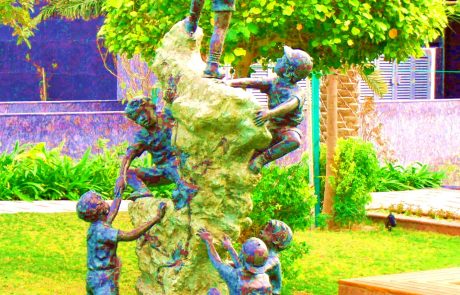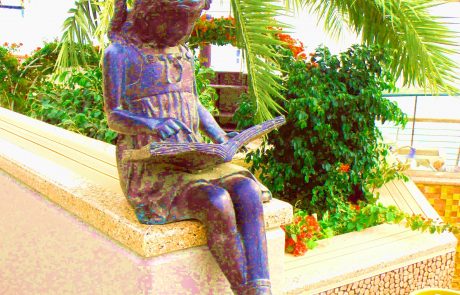June 2018
I was last in Bahrain in 2015, three years ago now. I used to go often during the five years I lived in Saudi Arabia, since I had the good fortune to live in Dhahran, on the Gulf Coast only an hour’s drive away across the King Fahad Causeway. For those expats like me who lived in the Dhahran/Khobar/Dammam conurbation, Bahrain was the Promised Land. Reasons for that assessment differed depending on the proclivities of the expat you asked, to be sure. For many — and I myself am not included in this category — it was the weekend getaway where liquor flowed like milk and honey, as long as your wallet could take the hit. Yes, kids, you can drink actual alcohol in Bahrain at the hotels and in some restaurants, which in Saudi Arabia is impossible, since it’s as dry as a bone, at least above board. So expat tipplers headed over almost every weekend to the hotel bars to live it up as was their wont from whence they came. Saudis did the same, by the way, and are known to be far rowdier than the expats, since they like especially to mix their wine (Jack Daniels grand cru reserve LMAO) with women who are, so go the reports, disposed to accept financial tokens of admiration from gentlemen of recent acquaintance. Mention Bahrain in eastern Saudi Arabia and the notion that jumps immediately to most minds be they expat or local is: Party Central. As an expat one learns quickly by word of mouth which areas in Manama to frequent and which to avoid. It would hardly do to get caught up in one of the brouhahas staged by the Saudi Rowdies in the areas they are wont to occupy on Exhibition Road. Having your Saudi employer fish you out of a Bahraini jail is the last thing you want to see happen. So we white folk stayed well clear of such areas, which cost me no tears of regret.
My purposes for going to Bahrain were entirely different. I went for the significant difference in atmosphere, at least in the first year of my stay in the area. But lamentably, that atmosphere changed drastically over the course of my years in Saudi. I want to give a fond tribute to what Bahrain was on my first meeting with it and to cast a wistful glance over the process of change I observed. In the last two years before I left KSA my visits to Bahrain became less and less frequent as the situation in the country continued its path of deterioration. By the time I left in 2015 the situation had started to become dicey in Saudi Arabia, as well, because of increased ISIS activity. The timing of my permanent departure from the Gulf was good. When I arrived money grew on trees and the good times rolled without thought for the morrow. By the time I left in 2015 the price of oil had tanked and ISIS bombings had occurred both in Dammam and Hofuf. Exit, stage left, seemed the best idea in the world.
Those who follow news from the Middle East will know that in 2011 there was an uprising in Bahrain by the Shia majority in protest against the minority Sunni regime of the country. Trouble had been brewing for years, it tipped over the edge in February 2011 and mass demonstrations erupted in the Pearl Roundabout near one of the posh areas of Manama, the Seef District, which was occupied by protesters for some weeks. Saudi Arabia sent tanks and troops over the Causeway to help the Sunni rulers of Bahrain quell the disturbance. The demonstrations were broken up but normalcy was never truly restored — the normalcy that existed when I first visited the country in late 2010. The conflicts continued and other disturbances occurred regularly. The carefree and easy feeling I had on my first visit to Bahrain never came back to me on visits subsequent to the uprising. Year by year I observed the situation worsen as my heart sank ever farther toward my shoes.
I’ve just checked the news from Bahrain, something I’ve not done in a long while. The headlines from Gulf News include “Bahrain Deplores European Parliament Resolution” (here); the European Parliament is shaking its finger at Bahrain once again for its human rights record. A look at the 2018 report on Bahrain by Human Rights Watch (here) does nothing to change the direction of that sinking feeling I remember only too well. The 2017/2018 report by Amnesty International (here) is hardly more uplifting. The troubles continue because the underlying tensions between the two factions involved, Shia and Sunni, have no real possibility of resolution. The same intractability is characteristic of tensions between those two groups in eastern Saudi Arabia, where two years before my final departure in 2015 violence erupted in the Shia area of Qatif, north of Dammam, to the point that US citizens were told by the US Embassy it was a no-go area. That means if you, as an American citizen, go there and get into trouble, you’re on your own. The U.S. government will do nothing to help you. Puts rather a fine point on it, to be sure. But let’s go back for a moment to 2010. I want to describe my first visit to Bahrain and what a delight it was, because that, too, is part of what Bahrain was and will, I sincerely hope, become once again.
I arrived in Saudi Arabia in November of 2010 to start a new job. It takes a while to get all the paperwork done — residency visa, Saudi driver’s license, etc. etc. — but eventually you have it all in hand and then you need to validate the visa by going across a border. With Bahrain so near, the choice of where to go was a no-brainer. Someone who became a good friend invited me to go over with him for my first trip, since he was headed to Manama to visit some friends of his who lived there.
The King Fahad Causeway is a great thing. It connects Bahrain to Al Khobar as a full-on freeway built right over the Arabian Gulf. (Sorry, Persian Gulf for some of you, but if you live in Saudi Arabia you learn very quickly never ever to call it the “Persian” Gulf because it makes you sound like a sympathizer with those nasty Iranians across the water who are always causing trouble.) I’d done no research on Bahrain although of course I knew it was there. I was oblivious to its visitation pattern by expats clustered in the Eastern Province and by Saudi Rowdies from all over. But hey, no time like the present, I had my Saudi residency card in my wallet and it meant I could get into Bahrain with no visa, just show the card at Immigration and away we go. So off I went with my friend taking it all in as we drove along the Causeway after clearing the urban sprawl of Khobar.
It was mid-December, so I’d been over a month in Saudi. Some acquaintances and I had poked about Khobar and Dammam on the weekends to scope things out. In that amount of time a process of adaptation occurred and my perception had become used to a particular urban landscape common in Saudi but not in the other Gulf states. Saudi is a very large country and the Gulf Coast is a long way from Riyadh. Bahrain and the Emirates are much smaller in scale and nothing is far from Manama, Abu Dhabi or Dubai in their respective states. I think that difference in size means the Higher Ups in the smaller states always have their finger on the pulse of urban development or have one of their deputies doing that job for them. In Saudi Arabia that level of oversight — the Gulf semi-equivalent of city planning — appears to be lacking. As you drive down the roads of Khobar or Dammam you will see a towering office building standing by itself with run-of-the-mill shops nearby and a residential area behind it. The phrase that comes to mind is: higgeldy-piggeldy. If you have the money and the will you can, apparently, throw up an office tower anywhere you like. The cityscape this circumstance produces is wholly unlike what I was used to in the USA — or in Europe, for that matter. One adapts, of course, and the eye becomes used to the pattern as it overlays the one brought along from the home stomping ground. After all, Toto, we’re not in Kansas anymore, are we. You don’t have to be rocket scientist to figure that one out.
As you approach Bahrain after passing the man-made island midpoint on the Causeway where all the immigration and customs things happen, nothing extraordinary strikes the eye. It’s a flat piece of land barely sticking up out of the Gulf. If God put a straw in the Gulf and decided it would be fun to blow bubbles, Bahrain would be in big trouble. You can see tall buildings in the distance, but that distance is so great they look no more imposing than would a hillock on the horizon. As soon as you cross back onto terra firma, however, it becomes immediately apparent that not only are you not in Kansas anymore, you’re also no longer in Saudi Arabia.
As we drove on the highway toward the downtown area I said to myself, “OMG it looks like Seattle.” While driving down one of the main roads in Khobar seeing all the fast food neon signs aglow (McD’s, Burger King, KFC, it’s all there) I had also thought to myself, “Goodness sake, I might as well be in Arizona,” but the look of Bahrain differs by a completely different order of magnitude, and the differences go beneath mere appearances. They are structural. Bahrain reminded me of Seattle because its urban footprint was like what I’m used to seeing in the USA. And what footprint is that precisely? Zoning, coupled with the quality of looking organized and finished. Manama has districts that differ vastly from one another, some of which are poor and rough, I’ll be the first to admit that point, and of one such area I will speak later. The Seef area frequented by expats is predictably high-end, of course, and things there have been done with a certain amount of panache –although by no means on the same level as Dubai, where serious bling is the order of the day. The Seef area gives a pleasant impression of high-end modern functionality. And fortunately, what you see is what you get.
There are other things that made Bahrain feel to me like being in a Western country. Women can drive there. Saudi women just got the right to drive and it will be white-knuckle business sorting out how they’ll actually go about doing that in the Kingdom. During my years in KSA women were still not allowed to drive. In Bahrain women have always been free to drive, so it’s commonplace to see a woman wearing the hijab with designer sunglasses whip past you in her brand new BMW. Another thing: far more attention is paid to decorative detail in public space. The highway overpasses, for example, show that care has been taken concerning their appearance as well as their function. In Saudi that’s much less likely to be the case. All these things add up to create a very different general impression in Bahrain that I felt very strongly on my first visit. I saw immediately why expats flocked there of a weekend. I think they’d have done the same even without the availability of alcohol in the hotels and restaurants. Just being in a place where you — and everyone else — could breathe more freely was a welcome change.
The size of Bahrain also plays its part in the different impression the country gives. It’s a country, yes, but it’s also a relatively small island with only one major city: Manama. The bulk of development efforts in the country go, of course, to the improvement of Manama. Likewise, in the UAE there is only one city gobbling up state development money in each Emirate, be it Abu Dhabi or Dubai or Sharjah. In Saudi Arabia there are regions so far apart that flying is the only easy way to move between them. In so large a country development occurs in its several regions according to the lights of the ruling member of the royal family installed there. In the area where I lived, for example, a developer had started a huge mall very near the Corniche (the area near the coastline). Permissions to do this and that must come from government officials, of course, and the then ruler of the province apparently liked to skim a tidy percentage of construction costs off the top of any major project in his area and funnel it into his own already bulging pockets. The developer balked at the notion so the project stopped dead in its tracks. The colossal and cavernous hulk of the unfinished building stands to this day on the Corniche, looking like something left over from the Apocalypse. That sort of eyesore is uncommon in Bahrain. It shows very clearly in Bahrain’s cityscape, too, which looks like a proper city should if you come from my part of the world.
Driving in Bahrain was a delightfully different experience. In Saudi Arabia it’s the Wild West out on the roads and if you don’t do as the locals do, you’re likely to get creamed. Bahrain drives on the right, but the road system was taken from the British. There are roundabouts, not just intersections with traffic lights. Because the area of the country is so much smaller and — before 2011 in any case — the state coffers were full enough to do things well, the roads are wonderful. The signage is large and clear and most importantly, accurate. I remember driving in Hofuf in Saudi Arabia where the signs are only in Arabic (which I read very imperfectly). Nobody thought to mention that half the city streets were under construction to the point that almost every route was a detour. Kiss your GPS goodbye, kids — useless as the day is long. Driving through the city was like running a go-cart course plotted out by somebody on LSD. There’s thankfully none of that business in Bahrain — everything is orderly and people don’t drive like lunatics as they do in Saudi because they’ll get busted, just like they do in the UAE. (Thank God for small favors.) Whenever I drove to Bahrain I breathed a sigh of relief as soon as I reached the freeway going into Manama from the western edge of the island. I knew I’d entered a space where the rules I could expect others to observe on the road resembled what I knew from the USA, instead of finding myself in a vehicular reenactment of the shootout at the OK Corral.
There’s one aspect of Bahrain that deserves special mention. I became aware of it on my first trip, but only as a background feeling I couldn’t have articulated clearly at the time. Only through exploring other areas of Manama and doing some research did I come to understand what I’d felt the first time I visited. That other aspect is water.
The name Bahrain means “two seas,” and two seas are in the picture because one of them is underground. The Bahrain Authority for Culture and Antiquities has an excellent piece on the phenomenon and its historical importance here. “Eternal Springs,” so goes the title. The history in legend goes very far back — all the way, some say, to the Garden of Eden. The archeological record takes us back as far as the Dilmun civilization (an informative albeit mildly annoying article on which is here, and and an excellent BBC article is here). That puts us a long way back, indeed, into the chronological range of Sumer and the Indus Valley civilization. The Dilmun civilization had active trade relations with both those areas. I knew nothing about Dilmun or Bahrain’s ancient history at the time of my first visit. My physical being, however, sensed the presence of water straightaway, although the surface of Bahrain looks hardly different from that of eastern Saudi Arabia. It took a good while for my conscious awareness to catch up to my physical awareness and articulate the reasons for that state to my mind.
I’ve said in another post that each area of the Planet has its own feeling tone that acts on the individual in the manner of music, which is to say in a completely non-verbal and non-rational way. I registered that tone, for lack of a better word, on Bahrain as soon as I went onto the island for the first time. The feeling Bahrain induced in me has everything to do with the presence of water in a landscape that appears the last place on Earth where one could reasonably expect to find it. There are artesian springs on Bahrain — they’re still there, although not as luxuriant they were in ancient times. In the era of the Dilmun civilization they were extensive enough to earn Bahrain a place in the Mesopotamian mythology of Paradise, as an article by Paul Lewis from 1984 in The New York Times (here) explains very well.
In a manner typical of urban dwellers everywhere in the modern world, my trips to Bahrain with other expats meant doing city things — like going to cafes and restaurants or going to the movies at the Seef Mall. The reason going to a movie at the mall was a big deal for expats living in Saudi is because there are no movie theaters in KSA, they’re forbidden because they contribute to moral degradation, which point may have previously escaped your attention. If you think I’m talking balderdash just ask the Saudi Committee for the Promotion of Virtue and the Prevention of Vice (هيئة الأمر بالمعروف والنهي عن المنكر), they’ll sort you out in no time. So trips with friends to Bahrain were about the city and its urban offerings for entertainment, shopping, imbibing (of course) and such like. After several such forays it became clear to me that if I wanted to pursue the other Bahrain, the one with the ancient history and the eternal springs, I’d have to do it by myself. So that’s exactly what I did.
I drove over to Bahrain one weekend by myself with no other purpose than to find the old Bahrain, the one that occasioned this poem 4,000 years ago in the Sumerian city of Nippur (and is given in the article by Paul Lewis mentioned above):
The land of Dilmun is holy, the land of Dilmun is pure. In Dilmun no cry the raven utters, nor does the bird of ill-omen foretell calamity. The lion kills not, nor does the ravening wolf snatch away the defenseless lamb. Unknown is the wild dog who tears the kid. The dove does not conceal its head. No one here says, ”My eyes are sick,” no one here says, ”My head is sick,” no one here says, ”I am an old woman,” no one here says, ”I am an old man.” The maiden walks here in innocence. No lustrations need be poured. The somber death priest walks not here, by Dilmun’s walls he has no cause for lamentations.
Wow. Beats the cocktail bar at the Intercontinental Regency all to hell, that’s a no-brainer. So off I went to see what I could find in the expanse of modern Manama that communicated something of the old Bahrain I could still feel in the air. Contrary to what you might expect, I didn’t head for the archaeological sites open to the public. I did, however, decide to explore the areas in which they occur, found on the map today under the names Budaiya and Saar. The archeological sites are fine for scientists, but for the likes of me they’re no more than a few architectural remnants spread out over a hot piece of sand. I was after a different Old Bahrain and I knew the archeological sites wouldn’t help me find it. So I decided simply to drive around the areas where the sites occur and notice what I found there. Before too long I hit paydirt.
I came across a mango orchard. Yes, Bridget, MANGOES, growing in Bahrain right there in front of God and everybody. I hit the brakes, flipped on the turn signal and turned off into a sidestreet that went along one edge of the orchard. Let us remember our botany, kids: the mango is native to India’s tropical and subtropical regions. I repeat: tropical and subtropical. A desert will kill mango trees in no time flat. Yet here, on the desert island of Bahrain, stood a mango orchard. I’m sure there was an irrigation system in place that didn’t appear to the naked eye, but all the same, mango trees in Bahrain OMG AYS??
Several things happened to me in rapid succession as I stood there near the trees. First and foremost was a joining of physical awareness with cognitive comprehension. You can’t fool Mother Nature, and neither can you fool your own body. It’s part of the Planet and it knows what’s what, there’s no pulling the wool over its eyes no matter what claptrap your mind might give out through its ratiocinations. A feeling of deep relaxation came over me and into my mind came the awareness: the Planet’s native terms make life possible here. Why? Because I was standing on top of Bahrain’s second sea, the underground water that made the place famous in the ancient world. I could feel the water in the very air, just as I had done on my first visit, but now I understood the connection through lived experience. Water is life, and here under the surface of sandy, sunny Bahrain was water which bubbled up in some places nearby as artesian wells. The relaxation I felt was my body registering the presence of that native water, that giver of life, and it went slack with relief like a tow rope when the pull stops.
This experience occurred after I’d lived in Saudi Arabia for over a year. After having that experience in Bahrain, I understood fully the tension I felt underneath the course of my daily life in KSA, a tension always on the edge of my conscious awareness but never enough in the cognitive sphere to bring to articulation. Now I could articulate it very clearly. The environment I lived in in KSA, the shrubs and grass and petunias (and only petunias, living out a miserable existence until they croaked and were replaced by fresh sacrificial victims) were all a huge fake. They were kept alive by irrigation that came from recycled grey water, which itself came from water supplied by a massive desalinization plant in Al Khobar. The native terms of the environment I lived in would kill the plants in the short span of a few days. My own demise would not be far behind. I never felt at ease in Saudi Arabia as I did in Bahrain until I visited the Hejaz mountains and experienced a native biome with enough water to sustain a full plant community — including fruit trees like pears and peaches, which I’ve mentioned in another post on a trip to western KSA. In Eastern Province where I lived, I knew that if the Planet had its way without human intervention we’d all be toast in a heartbeat.
On the spot where I stood beside the mango trees, however, a civilization had flourished that 4,000 years ago had been celebrated in Sumerian poetry as a paradise. Until oil was discovered in the deserts of Eastern Province there was nothing but roaming Bedouin tribespeople. No civilization was possible there, it could find no sustenance. Dilmun on the island of Bahrain, however, had flourished for centuries. The sensation my body felt told me why that had happened. Water. I could feel it as if I myself had become a dowsing rod.
As I relive that experience in the writing of this, there comes forcefully to mind a passage in Rebecca West’s Black Lamb and Grey Falcon about her visit to Sveti Naum, near Ochrid in Macedonia, with the pivotal word “eupeptic” at its center. Here is the passage:
” … When one first comes to Sveti Naum one simply thinks, ‘Why, there is water everywhere.’ But the situation is more unusual than that, for in many parts of the world dry land is only a figure of speech. Here one finds oneself saying, ‘But the trees and the flowers and the grass in this place have never been thirsty, and the air has never been dusty,’ and there is a eupeptic air about the scene, as if the earth had here attained a physiological balance in this matter of moisture rarely to be found elsewhere. And this is no illusion. Beyond the range of black rock on the left the Lake of Prespa, which covers about a hundred and twenty square miles, lies five hundred feet higher than Lake Ochrid, and has no visible outlet. Its waters percolate through the base of this range and arrive at these flatlands in a spread network that forms a perfect natural irrigation system, so that it emits refreshment to the eye, the nostril, the skin.”
Refreshment, registered by the body. Exactly that eupeptic sense came to me beside the mango trees, despite the fact that the water lay well beneath my feet. My body knew it was there, so it relaxed. Whenever I went to Bahrain, the feeling always returned, because the water is there, beneath the surface, and the body cannot be told that death by sun and sand will be its rapid fate when there’s a sea of fresh water beneath one’s feet.
Matters on the surface, however, were anything but eupeptic. Here I relate one experience that serves as a case in point for similar occurrences across the Manama area outside those districts rigidly controlled for tourist traffic. In the course of one visit to Budaiya I met a local man who lived in Saar, the village immediately south of Budaiya, and as is my wont even without the aid of Jack Daniels grand cru I held forth enthusiastically about the history of Dilmun and Bahrain’s second sea. The man was astonished to find a white expat so knowledgeable about the history of his native land, so he invited me to visit his home in Saar village to take tea and meet his family. So kind an offer was more than I could refuse, although I knew by that point, three years into my sojourn in the area, that going into a Shia village on Bahrain was not the best idea. I had a guide and host, however, so I agreed and off we went.
As we drove toward his house through Saar I found a scene as different as can be imagined from the high-end Seef area where the tourists hang out. The neighborhood screamed poverty. Shortly before we arrived at my host’s house, we came across a pile of burning tires blocking half the road. We skirted around them, watched by an ancient woman who looked as if she’d been left out in the desert to die and was then brought back by someone who thought better of it, only shortly before that purpose was accomplished. You don’t see old people like that in the tourist area. You hardly see old people there, period. Along the street as we turned into my host’s driveway I saw kids playing, looking like urchins from Dehli rather than citizens of one of the wealthy Gulf states. One toddler playing with his pal on the side of the road had only a top on but was bare from the waist down. You don’t see that in Seef Mall either, Bridget, trust me on that one.
As is the case with Arabs throughout the Gulf, the hospitality offered was lavish and graciously delivered. The conversation served more to satisfy my host’s curiousity about my home overseas than to answer the many questions I had about his, but as a guest I wanted to please my host in return for his hospitality, so the talk followed whatever direction he set for it.
The last time I went to Bahrain in 2015, once again by myself, I went back to Budaiya because I wanted to be near the place where I had first experienced the second sea. My time in the Gulf was soon to come to an end. As I drove along the road going from the main freeway to Budaiya I saw the walls of the buildings covered in political graffiti, scrawled in garish colors with cans of spray paint. At a small mall in Budaiya where I used to get my lunch I sat on the terrace of the Starbuck’s while I drank my Americano. Some mintues passed, then I suddenly noticed an odd sensation in my nostrils: a slight stinging, as if I’d put my nose over a bottle of ammonia. It took only a moment to dawn on me: tear gas. Some disturbance was taking place in Saar, the Shia village I’d visited, which lay just behind the mall, and the authorities were handling the matter with tear gas. I left my coffee on the table and dashed to my car. The second sea was still beneath my feet, but above the ground paradise had clearly become a commodity in very short supply.
The economic consequences of the uprising and its aftermath have been harrowing in the extreme. Eight years after the 2011 uprising the troubles continue with no end in sight. What will become of Bahrain as time marches on, I know not. I know from my own experience what a paradise it could be. My hope for the island and its people is that somehow they will find their way to a renewal of what existed there 4,000 years ago, when they inspired the poets of Nippur to sing their praises.

